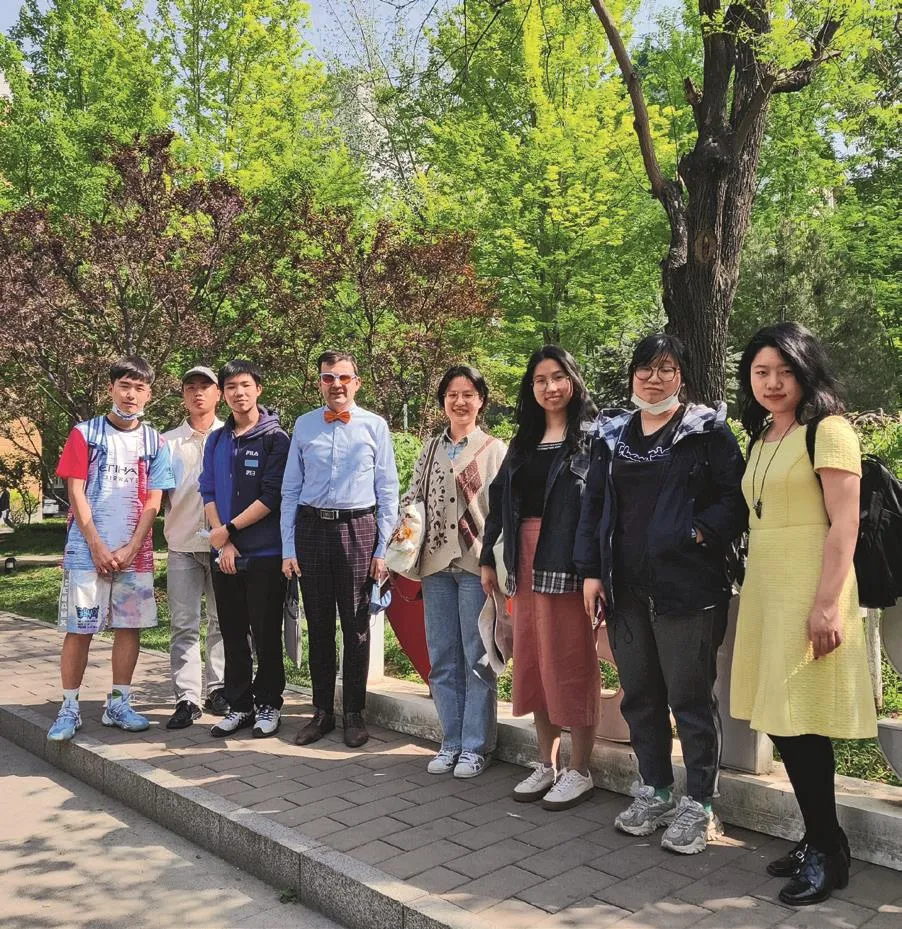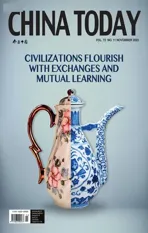Mirroring Two Anicent Civilizations
2023-11-08BystaffreporterMENGJIAXIN
By staff reporter MENG JIAXIN
In the eyes of Croatian archaeologist Goran Durdevic,an ancient mirror can also reflect cultural exchanges along the ancient Silk Road.

Goran is giving a lecture at Beijing Foreign Studies University.
GORAN Durdevic, aged 35, is an archaeologist from Croatia.Since 2013, following the launch of the Belt and Road Initiative(BRI), there has been increasing cooperation between Chinese universities and those in B&R member countries.This entailed some Chinese universities expanding enrollment to include international students from those countries.In 2017, Goran, who was in Croatia at the time, saw the news of the enrollment and applied to study at the School of History at Capital Normal University in Beijing, China.During his six-year stay in China, he carried out comparative research on bronze mirrors from the Chinese Han Dynasty (206 BC-AD 220) and ancient Rome.When it comes to the Chinese and Western allusions pertaining to mirrors, Goran can name a list of ancient Chinese philosophies which are inspiring to him.“In the Tang Dynasty (618-907), people believed that by using copper as a mirror, one could check one’s physical appearance; by using people as a mirror,one could understand gains and losses; and by using history as a mirror, one could know the rise and fall of regimes.”
Tracing History
Since childhood, Goran had been very interested in history and culture.At the age of 19, he was admitted into the Department of Archaeology at the University of Zadar in Croatia, where he studied ancient Roman history.Croatia was a part of the Roman Empire a long time ago, and was deeply influenced by Roman culture.During his time at the university, Goran not only studied Roman culture in depth, but also learned about history and cultures from all over the world,including China.Goran learned that there was a formidable Han Dynasty in the east existing at the same time as the Roman Empire.His research therefore turned to the comparative study of the history of the Han Dynasty in China and that of ancient Rome.
In 2013, after China put forward the BRI, the Department of History at Capital Normal University began to enroll international students from other BRI countries.In 2017, Goran came to China and became the second Croatian student in the department and decided to study for a doctoral degree.“It was a very valuable experience for me,as I was very interested in the history of the East as well as the comparative study of Eastern and Western history.”
During his doctoral studies, he cast his eyes on ancient Chinese and foreign bronze mirrors.When he advanced his research, Goran focused his study on the ornamentation of Han Dynasty bronze mirrors.In addition to extensive reading,he also visited museums in places such as Xi’an,Shanghai, and Luoyang to do field research.
Bond with Mirrors
Goran spent four years thoroughly comparing and analyzing ancient Chinese and Western bronze mirrors from multiple perspectives, and finished his PhD degree with top grades.After graduation, he started to teach archaeology and history at Beijing Foreign Studies University,where he continued the comparative study of bronze mirrors from the Han Dynasty of China and ancient Rome.“Mirrors are very special artifacts.Today we all use mirrors, and they are small and inexpensive.Many people use them to put on makeup, but mirrors can be used for more than that.When you look in a mirror you can see yourself, your own expression and state of being;it’s about self-consciousness and creates a lot of associations.”
Goran’s research focuses on the ornamentation of Han Dynasty bronze mirrors.He further elaborated, “Studying the motifs and inscriptions on these mirrors is very important because they give us some messages.I want to explore how these messages relate to the social identity of people,how they are linked to beauty, how the symbolism represented by these motifs was found, and why we find them on mirrors.”
As an example, he said that most of the motifs from the Western Han Dynasty (206 BC-AD 24)expressed the theme of nature, such as the “Nebula Mirror,” in which the rounded, raised portion of the mirror symbolizes a star, and the circular arc next to it symbolizes a cloud.Patterns on bronze mirrors are often associated with people’s attitudes towards life.For example, the mirror would be engraved with the words “longevity for your children and grandchildren, their life lasts as long as gold and stone.” Blessings like this appear to be advertisements at the time to help boost the sales of mirrors.By the middle and late Eastern Han Dynasty (25-220), there were some portrait mirrors that told stories about people and history, and most of these portrait mirrors contained profound philosophies of life.“Because in that era, most of the people were usually not literate,and thus lacked reading ability, they could only gain information through images.We can see that different decorations tell different stories; some about prominent historical figures, some about immortal figures from folklore, and Taoist, Confucian, and Buddhist thought, so the mirrors served as a great medium for presenting these stories,”Goran explained.
ORNAMENTATION
Goran focused his study on the ornamentation of Han Dynasty bronze mirrors.In addition to extensive reading,he also visited museums in places such as Xi’an, Shanghai,and Luoyang to do field research.
Promoting Mutual Understanding
Goran also visited many foreign museums.He found some inscriptions on the ancient Roman mirrors that wished good luck, while ancient Romans also had mirrors with local history and mythological stories carved on the back.“Roman culture is based on a mix of cultures from different parts of the Mediterranean.Although the two countries had different cultures and ideas, as empires, the ways of spreading political and social information were similar.”

Goran and a group of students take a photo together after an outdoor observation class.
Mirror motifs of the Western Han Dynasty are more decorative, with some abstract elements and geometric patterns, while those of the Eastern Han Dynasty are more figurative, depicting specific characters or philosophical ideas, especially those of Taoism.He took the TLV mirror as an example, which holds an important place in the history of the bronze mirror.It is also known as the“regularity mirror,” with patterns in the shape of letters of T, L, and V being regularly distributed on the mirror.There are round decorations outside square patterns, representing the round sky and the square Earth — an ancient Chinese view of the universe.Through his research, Goran has learned that similar information can be found in mirrors from the Roman period: “On Roman bronze mirrors we can see a concentric circle meaning that the universe surrounds the earth.We call it a ‘coin mirror.’ The mirror is round with a coin wrapped around in the center.It means that when you look in the mirror you not only see yourself, but alsothe whole universe.These two types of mirrors reflect two cultures’ understanding of the universe.”

An ancient Chinese bronze mirror, now an object of Goran's studies.
In addition to teaching and research, Goran also tries to introduce China to audiences in Croatia and Southeast Europe.Goran participated in the recording of a documentary where he talked about Beijing’shutongs, the Grand Canal, and the Summer Palace, in Croatian.This documentary was broadcast on Croatian radio and television and streamed online.He believes it is a way to introduce China,and hopes that more people will become interested in archaeology.
The bookSilk, Dragons and Paper: Chinese Civilization, Culture, History and Archaeology, coauthored by Goran, has been published in Croatia.The book introduces the history and culture of China in Croatian, and Goran has added the knowledge of ancient Chinese bronze mirrors to the book.This book has become a textbook for studying Chinese culture at the history, archaeology, and art departments of Croatian universities.
Studying Chinese bronze mirrors for nearly six years, Goran fell in love not only with Chinese culture, but also a Chinese girl.In 2021, he met Chen Yarong, a girl from southeast China’s Fujian Province who was working as a post-doctoral researcher at Beijing Foreign Studies University.Chen studied museology and later art history.Their common passion for history and culture study brought them together.And in 2022, this couple held a charming, romantic wedding in Croatia.Chen often participates in Goran’s research on ancient mirrors and helps him proofread academic materials in Chinese.
Thanks to the BRI’s cultural projects, Goran has established a connection with China, and his research on Chinese and Western ancient mirrors further promotes the mutual appreciation of Chinese and Western civilizations and people-topeople exchanges.
Thanks to the BRI’s cultural projects, Goran has established a connection with China, and his research on Chinese and Western ancient mirrors further promotes the mutual appreciation of Chinese and Western civilizations and peopleto-people exchanges.
